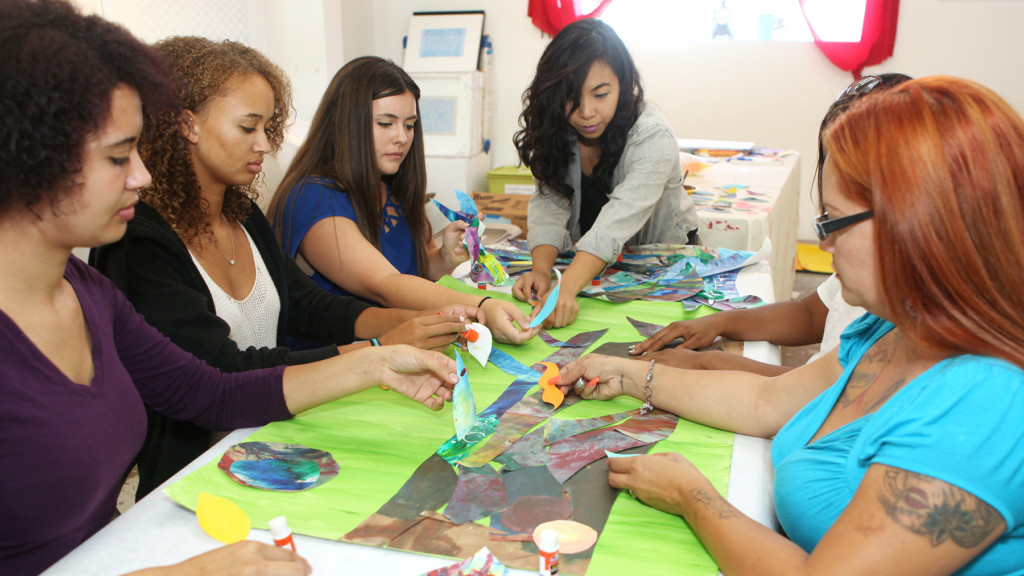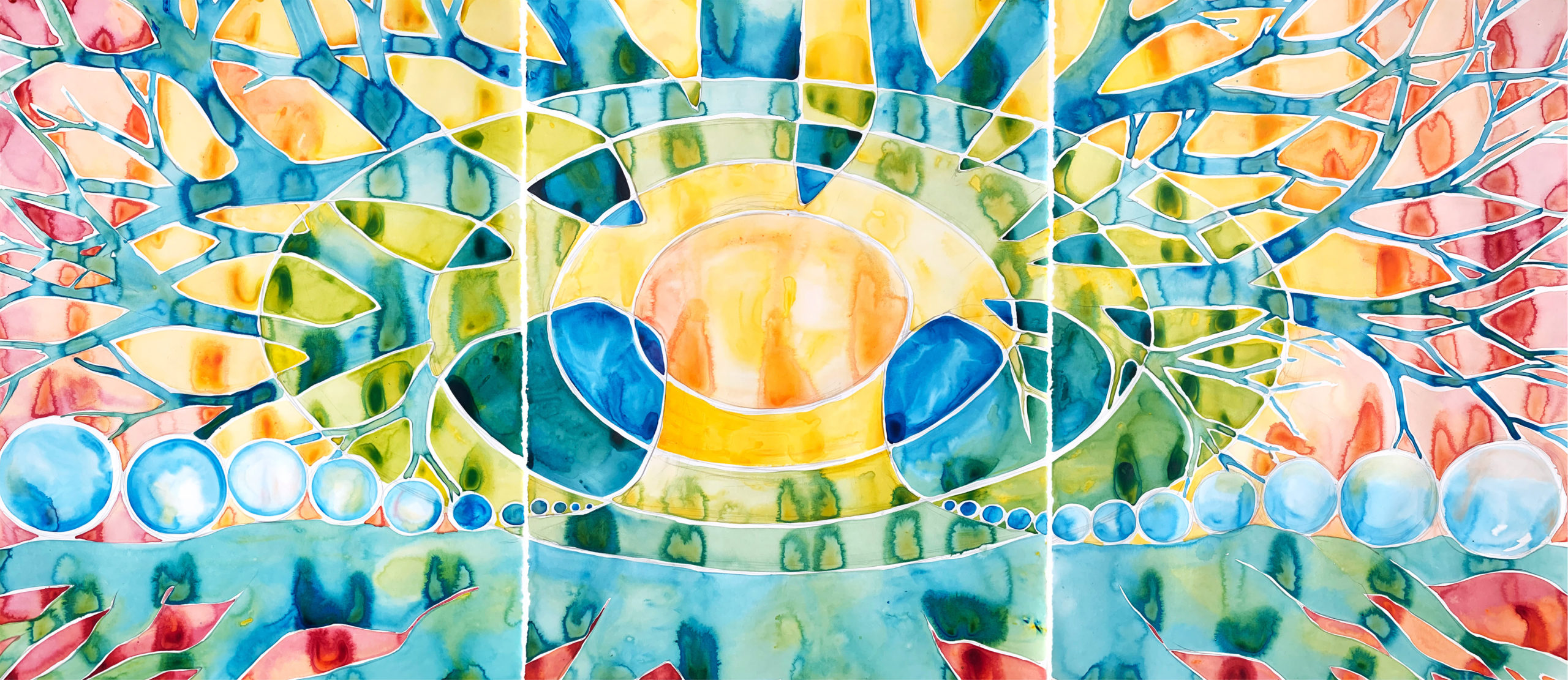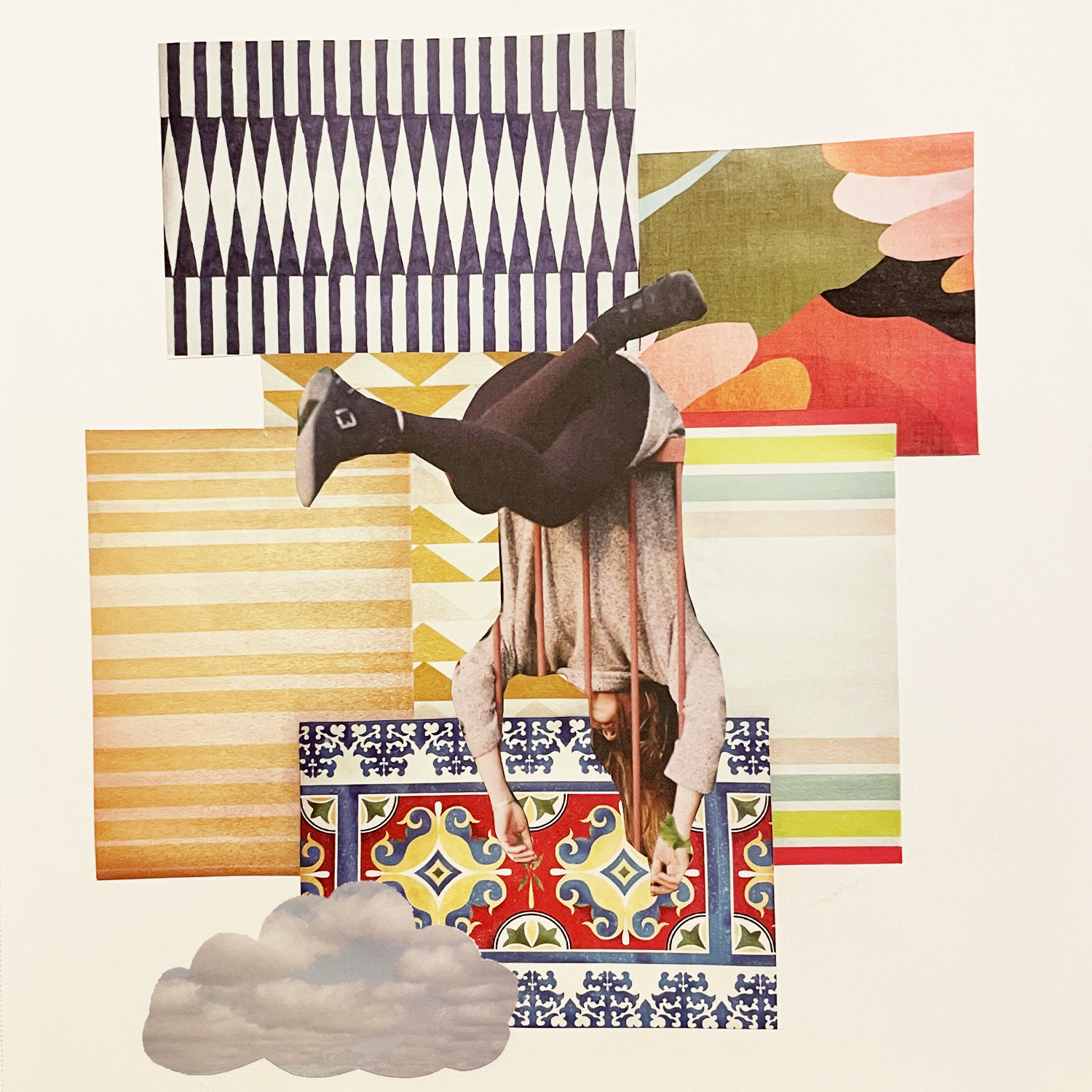by Sharon Brooke Uy, LMFT, ATR
Windows Facilitator & Workshop Author
Los Angeles, California
Imposter syndrome can feel like the collage above – like I’m falling past mismatched prints and trying to grab onto any one that might “match” that very second. Even now, there is an imposter part inside of me that tells me I can’t write anything useful. It blocks me. Or tries to, at least.
“The ‘imposter’ is the part of you that thinks it needs to have all the answers.”
I’ve written about imposter syndrome before, and right now, I’m not sure that it’s a syndrome (i.e., a set of symptoms), as much as it is the imposter part inside of me throwing a tantrum, getting loud and begging for my attention. It says that I should already be beyond the finish line, that I should have everything figured out.
The imposter has something to say in almost everything I do: when I’m in sessions with clients, when I’m making art or taking photos, and of course, when I’m writing.
The trouble is, I don’t usually remember that this voice saying these things is just a part of me. Instead, I take its word as my inner truth. But when I am clear and grounded, connected to my truest and most truth-knowing self, I know that that voice is not my own. The true me is simply observing a part that is talking, or throwing a tantrum.
And when the true “I” listens closely to that part, I can see that it’s just scared. It’s trying to save me from disappointment, judgment, failure, trouble. It cautions me to live small enough that I go unnoticed. Because if I live larger then I’m out in the open for hunting season. The imposter part is trying to protect me. But it doesn’t have to, because I, my true self, am in charge. And in that space, I know that I’m a spiritual being – consciousness, pure witness consciousness.
“The ‘imposter’ is the part of you that thinks it needs to have all the answers.” This is how my therapist blew my mind during a recent session when I relayed my own imposter syndrome as a therapist. Feeling like an imposter as a therapist comes up when I feel like I should have all the answers, or any of them, even though I don’t expect my therapist to have all the answers, or any of them. The whole exchange reminded me of a quote by Confucius: “He who knows all the answers has not been asked all the questions.”
In my previous post about imposter syndrome, I wrote about what it is, and listed what we can do to challenge it. In this post, I’d like to propose another way that merges art-making with Internal Family Systems (or IFS, or Parts Work) for working with the imposter inside.
A brief refresher: imposter syndrome is something that happens when one doubts their achievements and abilities and feels like a fraud. It can be a passing moment or a consistent feeling. Internal Family Systems (IFS) views a person as a system of various parts, each part having its own unique characteristics, beliefs, emotions, values, and purposes. So, in the context of IFS, imposter syndrome can be seen as a manifestation of a persnickety part of an individual’s internal system.
I kept trying to imagine the part of me that’s the imposter, and I just couldn’t visualize it, much less make art about it. It felt so elusive. So I scoured my old art journals and found several images that spoke to me, which reminded me that I don’t have to reinvent the wheel. I can find an existing answer somewhere inside. I learned something about my imposter part – that it wants to reinvent the wheel.
Once I had an image for my imposter part, I tried to befriend it. In IFS, we take time to listen to what they have to say, because it’s really the only way that they can feel heard and the only way they can relax. When a part wants to be heard (by us), and then isn’t, it throws a tantrum that usually intensifies until we are forced to listen. The more we ignore it, the louder it gets, until it overtakes us and, forgetting that it’s a part, we think the voice is our own. It’s the same as listening to someone else who speaks so staunchly that you forget your inner wisdom.
I began this post sharing all the things my imposter part had to say. I offered it space to speak its fears, and validated all that it felt. And in offering it my undivided attention and compassion, it quieted down, and in turn, I felt less like the imposter, and more like the being that I am, listening to that part.
Through this conversation, I developed a deeper understanding of this critical part and made space for its negative thoughts and beliefs to be released. This kind of inner work with the imposter inside can lead to a shift in perspective and a greater appreciation for one’s own abilities, and accomplishments. We can then work to integrate this part into the larger system within, offering it a new role, allowing it to serve as a source of support rather than a hindrance.
To recap, here are the steps for working with your inner imposter:
-
- Take some time to quiet the mind, perhaps closing your eyes and taking some meditative moments. Find the imposter inside of you. See what it looks like and notice how it feels. It might be a younger or different version of yourself, or something completely unrelated or unrecognizable to you. Draw it out as a depiction or a symbol, or make a sculpture or other representation.
- Allow yourself to let everything else fall away that isn’t one of the 8 C’s: compassion, curiosity, calm, courage, creativity, connectedness, clarity, confidence. This is how you know you are in your true Self. (You can make art about this, too!)
- Befriend the imposter part. Listen to all it has to say about itself. If you like, you can use your dominant hand to write out questions, and your non-dominant hand to write on behalf of the imposter.
- Your only job here is to listen, validate, and offer it support and presence. Then you can offer to help it release its old beliefs and call into itself new, more helpful ones.
- Make art to represent this new version of the part that was previously the imposter. Notice what’s changed about it. Send it and yourself gratitude for showing up for this practice.
The most important aspect of this work is to be kind. When you are being kind to a difficult part inside of you, you’re being kind to yourself, and it’s only from that place that all of your parts can live in harmony to form a peaceful Internal Family System.
by Sharon Brooke Uy, LMFT, ATR
Windows Facilitator & Workshop Author
Los Angeles, California
Download the accompanying Facing Imposter Syndrome worksheet created by the author!
Facing Imposter Syndrome Worksheet
Want to bring healing art programming to your community?
A Window Between Worlds (AWBW) supports hundreds of direct service organizations across the country to incorporate creative expression into their work with trauma survivors. With this blog we uplift the voices of our art workshop facilitators and participants. We invite you to take in this perspective, notice what resonates and explore how it may fit into your life.





